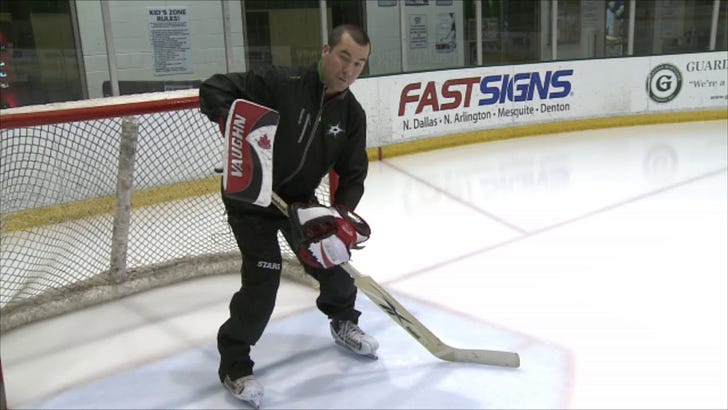How catching the puck has become a lost art for goaltenders
A look at bulky gloves, practice gloves, and other factors on something that's changed within the position.
Let’s start this post with the clip that sent me down this rabbit hole in the first place.
Bill Ranford, the Los Angeles Kings director of goaltending, was a guest on the Glass and Out podcast earlier this month.
It’s a fascinating episode all around, I would suggest listening to the whole thing, but the part that worm holed for me was the part about how catching the puck has become a lost art for goalies.
Here’s that segment reduced into a soundbite as a quick introduction.
As Ranford discusses, goalies still make glove saves, but they aren’t necessarily puck catchers anymore, rather puck trappers and doing more of the wrist twist rather than snapping the glove closed.
Ranford identifies a couple potential problems, pointing to a lack of cross-sport training and over specialization — he specifically mentioned baseball — and the usage of practice gloves by NHL goalies.
Practice gloves, for those who don’t know, are typically more heavily padded gloves that goalies use outside of games. They protect the palm and limit some wear-and-tear injury wise, but they are also harder to close and less “snappy” than a game glove.
And when you aren’t catching pucks in practice, instead twisting the wrist, that’s going to become the habit you naturally use in games.
Taking Ranford’s lead, I went on my own reporting trail to try and add some more context to this story, to look a little bit further at some of the reasons why catching the puck is a “lost art” and how we might have gotten here, and how it could potentially be addressed.
OK, before we get too deep into ripping something apart, we need to look at why the wrist twist even made sense in the first place, because like many goalie techniques it was a necessary innovation for one goalie, and a proper move, that others worked on copying.
Henrik Lundqvist is a Hockey Hall of Famer and was one of the NHL’s best and most consistent goalies for more than a decade, there are many goalies that are better today because Lundqvist really popularized playing deeper in his crease getting that extra millisecond to read a play against elite shooters.
He also made glove saves like this.
Now re-watch that glove save. It’s a great save, but one thing you’ll notice is his glove doesn’t close all the way.
Lundqvist in fact, couldn’t close his glove all the way, which he detailed a bit in this episode of InGoalRadio back in 2022, and how he played games with a wide-open, extra-padded practice glove.
“I didn’t feel comfortable with a glove that closed completely. I had to focus on opening it, this (practice) glove was always open and it was more just get it in the way and over time I started to use a little a softer glove, (but) there were years it was so stiff I couldn’t close it at all,” Lundqvist said on the podcast.
Lundqvist said the stiff glove was one of the reasons he struggled a puck handler too, when you can’t close the glove it’s kind of impossible to grip the stick efficiently, like Marty Turco popularized with the Turco Grip.
Lundqvist was influential in the goaltending world, honestly who didn’t want to be like him? He’s basically the goalie version of Nicklas Lidström, the perfect human, but with a bit more flair and he can play the guitar, he was the epitome of cool.
Even as a New Jersey Devils fan growing up and someone who got into the sport because of Martin Brodeur, I couldn’t hate the Rangers like I was supposed to once Lundqvist arrived during the 2005-06 NHL season.
Goalies like to copy and steal from others, which is one of the ways that Lundqvist’s save technique and wrist-twisting, with great success, became more popularized in the NHL.
Like Jonathan Quick and the RVH, goalies should have looked at why Lundqvist caught pucks this way rather than copying him directly. As goalies became more mechanical and robotic, it became more about adding tools than understanding them, something the entire goaltending industry is now trying to push back against, which I wrote about in 2023 here:
While Lundqvist popularized the wrist-twisting glove save as opposed to the glove-snapping glove save, the equipment itself put the change into overdrive.
I sat down with USA Hockey’s Manager of Goaltending Steve Thompson last week while he was helping run USA Hockey’s National Goalie Development Camp. Thompson has been big for USA Hockey in helping push the goalie development back against robotic teaching, he’s pushed to create “problem solvers not tacticians” and I find his view on goaltending quite refreshing.
So I asked him for his thoughts on the lost art of catching the puck, Ranford’s comments, and what he sees with all of that, especially while he was working a camp with some of America’s top goalies aged between 16 and 22 last week.
“In the NHL with how hard the shots are now, everyone is using practice gloves more for protection and they are bulkier, which causes them to get more of that flipping going on glove saves out of habit,” Thompson said. “And in the youth space we see so many youth goalie gloves that are so bulky and made for older kids, or maybe mom and dad prioritize buying the larger glove because it covers more space or covers more net. People think, at the youth level, bigger gloves means more saves. But it’s not teaching the mechanics to actually close the glove and watch the puck into your glove, all those little details you focus on with a properly sized glove.”
Thompson also put out a plea for goalie gear manufactures to take this into account when making youth goalie gloves.
“If we could have goalie gloves for youth, kids, that could be close, much like the older gloves did,” Thompson explained. “The older gloves weren’t as padded, they weren’t as fancy. Kids could learn how to close the glove. But when it’s bulky and padded, the way they are now, you learn how to make saves the other way and it’s counterintuitive to development, and that’s not good for anybody.”
To be clear on something, Thompson isn’t asking for youth goalie gloves to not protect goalies, he’s simply pointing out that at the youth level protection should match the level of shooters, you don’t need NHL-esque padding against 10-year-old shooters.
It really makes sense, when you learn to play goalie with a bulky glove, you learn to use it as a stopping tool and not a catching tool. And when you start making saves having to twist the wrist and not catching in your formative years, those habits will likely follow you for the rest of your life.
The cycle then becomes self-fulfilling, NHL goalies twisting the glove to make saves, young goalies watching and copying them.
I wanted to get an active NHL goalie’s voice on this, so I asked my pal Robert Tiffin to bring this topic up with Stars goalie Jake Oettinger.
Robert is one of the best covering the Stars and if you haven’t already followed his work, you really should here:
Oettinger, in my view, catches pucks. He’s not a wrist twister and it’s one of the reasons his rebound control, amongst other things, is one of the best in the NHL.
Oettinger talked about the equipment issue and said he’s fortunate now, as an NHL goalie, that he’s able to get new gloves whenever he wants, he also doesn’t use a heavier-padded practice glove. But earlier in his career, even when he was playing for the National Team Development Program, his glove was bulky and cumbersome.
“When I was at the program I had a glove that was basically a blocker with netting on it,” Oettinger said. “So that’s certainly true, you have to scoop (to catch) compared to actually catching and closing it. So my game gloves now close really well, and when I get a new game glove I turn it into my practice glove, so I’m lucky I can have the same feeling.”
Oettinger also said Ranford’s original theory, which got us started here, is true about goalie practicing how they play.
“Yeah I would agree with that, that’s the reason guys get used to scooping, you’re practicing so much and that’s when you’re getting your reps,” Oettinger said. “So guys get used to catching it that way and that’s how it naturally goes.”
The scoop or wrist twist also can look aesthetically pleasing, Oettinger said, there are glove saves where a simple catch is the best play, but if a goalie is scooping or twisting, it looks more like a crowd-pleasing windmill.
“I think a lot of guys do that for the fans, too, for some flair,” Oettinger said. “Then kids see that and they are just trying to windmill everything.”
Whether it’s technically the right move or not, and that’s probably dependent on the goalie, that extra motion on the scoop looks more impressive and draws “oohs and ahh” way more than simply watching the puck into the glove and holding it still.
It’s really a study in how one of the simplest elements and most boring one — a clean catch — is an art that’s nearly been lost to a combination of bulky equipment and dramatic flair.





I love Otter’s confidence with the glove save and the “I got this s***!” almost snarky attitude and flip of the puck after a solid catch.